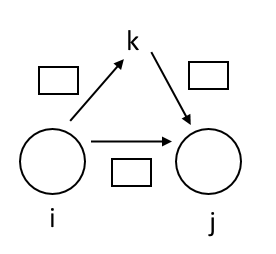Single Source, Shortest Path Algorithms
Definitions
(This all assumes that we're given a graph G = (V, E) and a weight function w : e → R)
- path: A list of vertices showing how to get from 1 vertex to
another in the graph.
We're really interested in the edges, but the list of vertices imply the list of edges between them - weight of a path: the sum of the weights of the edges on a path \(w(p) =\sum\limits_{i=1}^k w(v_{i-1}, v_{i}) \)
- shortest path weight of a path from u to v:
\[d(u,v) =\left\{ \begin{array}{ll} min(p): w(p): \{p \textrm{ is a path from u} \to v \} \textrm{(if at least one path exists)} \\ \infty, \textrm{if there is no path} \end{array} \right.\] - shortest path: is any path such that w(p) = d(p) and p exists
- cycle: a cycle is any path that starts and ends in
the same place. So ABCDA is a cycle.
Note that paths can (poentitally) contain cycles. ABCDEFCGH contains the cycle CDEFC.
Shortest Path for Unweighted Graphs
For unweighted graphs we can just use BFS to find the shortest path from the source node to any other node.
Shortest Path for Weighted Graphs
Problem: Given G = (V, E) and src ∈V, find a shortest path p (from src to v, ∀v ∈V)
A couple of important notes:
- Optimal Substructure:
A shortest path from src to v is composed of subpaths that are also the shortest subpath.
Given a shortest path: pick any point on it (let's name it t). The path from src to t is a shortest path from src to t.- This is important because both greedy algorithms and dynamic
algorithms exploit this optimal substructure property to to come up
with good, correct answers.
- This is important because both greedy algorithms and dynamic
algorithms exploit this optimal substructure property to to come up
with good, correct answers.
- Negative weight edges
In some cases a graph may contain negative edge weights (for example, if the edges represent financial actions, then getting (or giving) money might be represented with negative edge weights.
In some cases this might not make sense (e.g., when edges represent roads on a map) - Shortest paths never contain cycles
If a graph has a cycle with a net negative weight then the shortest path is undefined (because you can keep going around that cycle, and thus reducing the total each time).
If the graph has a cycle with a net positive weight it would be pointless to follow it (because doing so will increase the total but will not get you any closer to the destination vertex)
Pseudocode - Dijkstra's
<See notes from the prior lecture>
Note that Dijkstra's algorithm cannot handle negative weight cycles (in contrast to the Bellman-Ford Algorithm, below)
Pseudocode - Bellman-Ford
First, let's define the 'init' method:
| Θ( |V| ) |
Init(G, s)
s.dist = 0 |
The 'Relax' method will check if the distance from v1 to v2 is a shorter way to get to v2, and if so it will update v2 so that v2's parent/predecessor points back to v1 (and the distance is updated appropriately).
| Θ( 1 ) |
|
Note: Infinity + x is still infinity
The Bellman-Ford algorithm will go
through and repeatedly relax all the edges, checking (over and over) to see
if there's a shorter path between any of the vertices.
| Θ( |V| ) |
Bellman-Ford(Graph G, Vertex src)
Init(G, src) |
| Θ(|V| * |E|) | for( i = 1; i ≤ |G.V| - 1; i++ )
// note that we're just counting here - we need to do the inner loop
|G.V| times |
| Θ(|E|) | //
lastly, check for negative-weight cycles: |
| Θ( 1 ) :) | //No
negative weight cycles |
